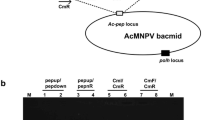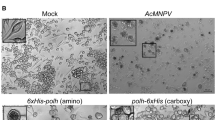Abstract
Baculoviruses are the ingenious insect pathogens. Outside the host, baculovirus occlusion bodies (OB) provide stability to occlusion-derived viruses (ODV) embedded within. The OB is an organized structure, chiefly composed of proteins namely polyhedrin, polyhedron envelope protein (PEP) and P10. Currently, the structural organization of OB is poorly understood and the role of OB proteins in conferring the stability to ODV is unknown. Here we have shown that the assembly of polyhedrin unit cells into an OB is a rapid process; the PEP forms in multiple layers; the PEP layers predominantly contribute to ODV viability. Full-grown OBs (n = 36) were found to be 4.0 ± 1.0 µm in diameter and possessed a peculiar geometry of a truncated rhombic dodecahedron. The atomic force microscopy (AFM) study on the structure of OBs at different stages of growth in insect cells revealed polyhedrin assembly and thickness of PEP layers. The thickness of PEP layers at 53 h post-transfection (hpt) ranged from 56 to 80 nm. Mature PEP layers filled up approximately one third of the OB volume. The size of ODV nucleocapsid was found to be 433 ± 10 nm in length. The zeta potential and particle size distribution study of viruses revealed the protective role of PEP layers. The presence of a multilayered PEP confers a viable advantage to the baculoviruses compared to single-layered PEP. Thus, these findings may help in developing PEP layer-based biopolymers for protein-based nanodevices, nanoelectrodes and more stable biopesticides.













Similar content being viewed by others
Abbreviations
- 3-D:
-
3-Dimensional
- AFM:
-
Atomic force microscopy
- BmNPV:
-
Bombyx mori nucleopolyhedrosis virus
- BV:
-
Budded virus
- FWHM:
-
Full width at half maximum
- HPT:
-
Hour post-transfection
- OB:
-
Occlusion bodies
- ODV:
-
Occlusion-derived virus
- PSD:
-
Particle size distribution
- PEP:
-
Polyhedron envelope protein
- SDS:
-
Sodium dodecyl sulfate
- SEM:
-
Scanning Electron Microscopy
References
Anduleit, K., Sutton, G., Diprose, J. M., Mertens, P. P., Grimes, J. M., & Stuart, D. I. (2005). Crystal lattice as biological phenotype for insect viruses. Protein Science, 14(10), 2741–2743. doi:10.1110/ps.051516405.
Aregueta-Robles, U. A., Woolley, A. J., Poole-Warren, L. A., Lovell, N. H., & Green, R. A. (2014). Organic electrode coatings for next-generation neural interfaces. Frontiers in Neuroengineering, 7, 15. doi:10.3389/fneng.2014.00015.
Baro, A. M., & Reifenberger, R. G. (2012). Atomic force microscopy in liquid: biological applications, part 1.8 (1st ed., pp. 28–29). Weinheim: Wiley-VCH Verlag.
Bergold, G. H. (1963). An advance treatise. In E. A. Steinhaus (Ed.), Insect pathology: An advance treatise (pp. 413–455). New York: Academic Press.
Bird, F. T., & Burk, J. M. (1961). Artificial disseminated virus as a factor controlling the European spruce sawfly, Diprion hercyniae (Htg) in the absence of introduced parasite. The Candian Entomologist, 93, 228–238.
Carpentier, D. C. J., Griffiths, C. M., & King, L. A. (2008). The baculovirus P10 protein of Autographa californica nucleopolyhedrovirus forms two distinct cytoskeletal-like structures and associates with polyhedral occlusion bodies during infection. Virology, 371, 278–291. doi:10.1016/j.virol.2007.09.043.
Chiu, E., Coulibaly, F., & Metcalf, P. (2012). Insect virus polyhedra, infectious protein crystals that contain virus particles. Current Opinion in Structural Biology, 22(2), 234–240. doi:10.1016/j.sbi.2012.02.003.
Christian, P. D., Gibb, N., Kasprzak, A. B., & Richards, A. J. (2001). A rapid method for the identification and differentiation of Helicoverpa nucleopolyhedroviruses (NPV Baculoviridae) isolated from the environment. Journal of Virological Methods, 96, 51–65.
Coulibaly, F., Chiu, E., Gutmann, S., Rajendran, C., Haebel, P. W., Ikeda, K., & Metcalf, P. (2009). The atomic structure of baculovirus polyhedra reveals the independent emergence of infectious crystals in DNA and RNA viruses. Proceedings of the National Academy of Sciences, 106(52), 22205–22210. doi:10.1073/pnas.0910686106.
Di, X., Sun, Y. K., McCrae, M. A., & Rossmann, M. G. (1991). X-ray powder pattern analysis of cytoplasmic polyhedrosis virus inclusion bodies. Virology, 180, 153–158.
Driskell, J. D., Jones, C. A., Tompkins, S. M., & Tripp, R. A. (2011). One-step assay for detecting influenza virus using dynamic light scattering and gold nanoparticles. Analyst, 136, 3083–3090. doi:10.1039/c1an15303j.
Engstrom, A., & Kilkson, R. (1968). Molecular organization in the polyhedra of Porthetria dispar nuclear-polyhedrosis. Experimental Cell Research, 53, 305–310.
Ernst, W., Grabherr, R., Wegner, D., Borth, N., Grassauer, A., & Katinger, H. (1998). Baculovirus surface display: Construction and screening of a eukaryotic epitope library. Nucleic Acids Research, 26(7), 1718–1723. doi:10.1093/nar/26.7.1718.
Gotfredsen, K. (2015). Implant coatings and its application in clinical reality in implant surfaces and their biological and clinical impact. In A. Wennerberg, T. Albrektsson, & R. Jimbo (Eds.), Implant surfaces and their biological and clinical impact, ch 11 (pp. 157–178). Berlin: Springer.
Gross, C. H., Russell, R. L. Q., & Rohrmann, G. F. (1994). Orgyia pseu- dotsugata baculovirus p10 and polyhedron envelope protein genes: Analysis of their relative expression levels and role in polyhedron structure. Journal of General Virology, 75, 1115–1123.
Harding, S. E. (1986). Applications of light scattering in microbiology. Biotechnology and Applied Biochemistry, 8, 489–509.
Heimpel, A. M., Thomas, E. D., Adams, J. R., & Smith, L. J. (1973). The presence of nuclear polyhedrosis virus of Trichoplusia ni on cabbage from the market shelf. Environmental Entomology, 2, 72–75.
Hughes, K. M. (1978). The macromolecular lattices of polyhedra. Journal of Invertebrate Pathology, 31(2), 217–224.
Ihalainen, T. O., Laakkonen, J. P., Paloheimo, O., Ylä-herttuala, S., Airenne, K. J., & Vihinen-ranta, M. (2010). Morphological characterization of baculovirus Autographa californica multiple nucleopolyhedrovirus. Virus Research, 148, 71–74. doi:10.1016/j.virusres.2009.11.017.
Ji, X., Sutton, G., Axford, D., Owen, R., Stuart, D. I., & Evans, G. (2010). How baculovirus polyhedra fit square pegs into round holes to robustly package viruses. The EMBO Journal, 29(2), 505–514. doi:10.1038/emboj.2009.352.
Khurad, A. M., Zhang, M., Deshmukh, C. G., Bahekar, R. S., Tiple, A. D., & Zhang, C. X. (2009). A new continuous cell line from larval ovaries of silkworm, Bombyx mori Vitro Cellular & Developmental Biology. Animal, 45(8), 414–419. doi:10.1007/s11626-009-9197-2.
Kost, T. A., Condreay, J. P., & Jarvis, D. L. (2005). Baculovirus as versatile vectors for protein expression in insect and mammalian cells. Nature Biotechnology, 23(5), 567–575. doi:10.1038/nbt1095.
Kuznetsov, Y. G., & McPherson, A. (2011). Atomic force microscopy in imaging of viruses and virus-infected cells. Microbiology and Molecular Biology Reviews, 75(2), 268–285. doi:10.1128/MMBR.00041-10.
Lua, L. H. L., Nielsen, L. K., & Reid, S. (2003). Sensitivity of Helicoverpa armigera nucleopolyhedrovirus polyhedra to sodium dodecyl sulfate. Biological Control, 26(1), 57–67. doi:10.1016/S1049-9644(02)00116-0.
Makela, A. R., & Blom, C. O. (2008). The baculovirus display technology—An evolving instrument for molecular screening and drug delivery. Combinatorial Chemistry & High Throughput Screening, 11(2), 86–98. doi:10.2174/138620708783744525.
McCooey, D. I. (2014). Chamfered Cube (all Edges Equal). N.p. http://www.dmccooey.com/polyhedra/ChamferedCube1.html. Accessed 11 December 2014).
McDougall, L. A., Holzapfel, W. H., Schillinger, U., Feely, D. E., & Rupnow, J. H. (1994). Scanning electron microscopy of target cells and molecular weight determination of a bacteriocin produced by Lactococcus lactis D53. International Journal of Food Microbiology, 24, 295–308.
Miller, L. K. (1997). Introduction to the Baculoviruses. In L. K. Miller (Ed.), The Baculovirus, Ch. 1 (pp. 1–5). New York: Plenum Press.
Minion, F. C., Coons, L. B., & Broome, J. R. (1979). Characterization of the polyhedral envelope of the nuclear polyhedrosis virus of Heliothis virescens. Journal of Invertebrate Pathology, 34, 303–307.
Nečas, D., & Klapetek, P. (2012). Gwyddion: An open-source software for SPM data analysis. Central European Journal of Physics, 10(1), 181–188.
Paul, A., Binsalamah, Z. M., Khan, A. A., Abbasia, S., Elias, C. B., Shum-Tim, D., & Prakash, S. (2011). A nanobiohybrid complex of recombinant baculovirus and Tat/DNA nanoparticles for delivery of Ang-1 transgene in myocardial infarction therapy. Biomaterials, 32(32), 8304–8318. doi:10.1016/j.biomaterials.2011.07.042.
Paul, A., Elias, C. B., Shum-Tim, D., & Prakash, (2013). Bioactive baculovirus nanohybrids for stent based rapid vascular re endothelialization. Scientific Report, 3, 2366.
Pidre, M. L., Ferrelli, M. L., Haase, S & Romanowski, V. (2013). Baculovirus Display: A Novel Tool for Vaccination. In Romanowski, V. (Ed.), Current Issues in Molecular Virology - Viral Genetics and Biotechnological Applications (ch. 6, pp. 137–164). Rijeka: InTech. ISBN: 978-953-51-1207-5, DOI: 10.5772/55572. Available from: http://www.intechopen.com/books/current-issues-in-molecular-virology-viral-genetics-and-biotechnological-applications/baculovirus-display-a-novel-tool-for-vaccination.
Rohrmann, G. F. (2013). Baculovirus molecular biology. Bethesda (MD) 3rd edn, National Library of Medicine (US), National Centre for Biotechnology Information; http://www.ncbi.nlm.nih.gov/books/NBK114593/.
Rubinstein, R., & Polson, A. (1983). Midgut and viral associated proteases of Heliothis armigera. Intervirology, 19, 16–25.
Samandoulgou, I., Fliss, I., & Jean, J. (2015). Zeta potential and aggregation of the virus-like particle of Human Norovirus and Feline Calicivirus under Different Physicochemical Conditions. Food and Environmental Virology, 7, 249–260.
Slack, J., & Arif, B. M. (2007). The baculoviruses occlusion-derived virus: virion structure and function. Advances in Virus Research, 69, 99–165. doi:10.1016/S0065-3527(06)69003-9.
Slavicek, J. M., & Popham, H. J. (2005). The Lymantria dispar nucleopolyhedrovirus enhancins are components of occlusion-derived virus. Journal of Virology, 79(16), 10578–105788.
Smith, K. M., & Wyckoff, R. W. (1950). Structure within polyhedra associated with insect virus diseases. Nature, 166, 861–862.
Torquato, E. F. B., Neto, M. H. M., Brancalhão, R. M. C., & Franco, V. S. (2006). Nucleopolyhedrovirus: Scanning electron microscopy technique. Neotropical Entomology, 35(6), 787–790.
Whitt, M. A., & Manning, J. S. (1988). A phosphorylated 34-kDa protein and a subpopulation of polyhedrin are thiol linked to the carbohydrate layer surrounding a baculovirus occlusion body. Virology, 163(1), 33–42.
Wulfmeyer, T., Polzer, C., Hiepler, G., Hamacher, K., Shoeman, R., Dunigan, D. D., & Meckel, T. (2012). Structural organization of DNA in chlorella viruses. PLoS One, 7(2), e30133. doi:10.1371/journal.pone.0030133.
Yang, J., Balasundaram, G., Lo, S. L., Guang, E. C. S., Xue, J. M., Song, J., et al. (2012). Microfibers fabricated by non-covalent assembly of peptide and DNA for viral vector encapsulation and cancer therapy. Advance Materials, 24, 3280–3284. doi:10.1002/adma.201201145.
Yao, L. G., Liu, Z. C., Zhang, X. M., Kan, Y. C., & Zhou, J. J. (2007). A highly efficient method for the generation of a recombinant Bombyx mori nuclear-polyhedrosis-virus Bacmid and large-scale expression of foreign proteins in silkworm (B. mori) larvae. Biotechnology and Applied Biochemistry, 48, 45–53. doi:10.1042/BA20070017.
Acknowledgments
The authors greatly acknowledge the instrument facilities provided by the Karnatak University Scientific Instrumentation Centre, Dharwad, Karnataka, India.
Author information
Authors and Affiliations
Corresponding author
Electronic supplementary material
Below is the link to the electronic supplementary material.
Rights and permissions
About this article
Cite this article
Sajjan, D.B., Hinchigeri, S.B. Structural Organization of Baculovirus Occlusion Bodies and Protective Role of Multilayered Polyhedron Envelope Protein. Food Environ Virol 8, 86–100 (2016). https://doi.org/10.1007/s12560-016-9227-7
Received:
Accepted:
Published:
Issue Date:
DOI: https://doi.org/10.1007/s12560-016-9227-7




